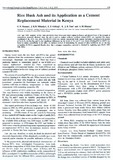| dc.description.abstract | AAS and XRD amdysls of rice husk ash (RHA) from Mwea and Ahero regions in Kenya, and physical tests of the strength of
cernenl;itious materials obtained when the ash is used to replace ordinary portland cement (OPe) are reported. The major
constitnent of the RHA was sHica (82.3-89.9%) which was mainly amorphous. Both regions had minor yariations in the amount
of Si, K, Fe, AJ,MD, Mg, aad Ca, but sigJUlic:ant differences in the levels of Na and P were found. Heating RHA to lOOO"C was
found to induce crystallinity in the silica. An indirect method of determining the amount of silica in RHA by use of the loss
on ignition (I.O.I) is suggested. Results show that a stroager cementitious material Is obtained by replacing upto 13.4% OPC
with RHA. | en |

